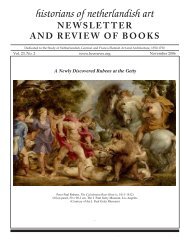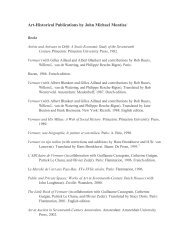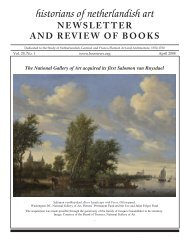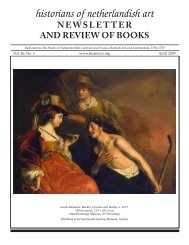newsletter - Historians of Netherlandish Art
newsletter - Historians of Netherlandish Art
newsletter - Historians of Netherlandish Art
Create successful ePaper yourself
Turn your PDF publications into a flip-book with our unique Google optimized e-Paper software.
historians <strong>of</strong> netherlandish art<br />
General editor: Kristin Lohse Belkin<br />
Area editors: Fourteenth and Fifteenth Centuries: Jacob Wisse;<br />
Sixteenth Century: Larry Silver; Seventeenth-Century Flemish: Fiona<br />
Healy; Seventeenth-Century Dutch: Frima Fox H<strong>of</strong>richter; German<br />
<strong>Art</strong>: Larry Silver<br />
Fifteenth Century<br />
Antje-Fee Köllermann, Conrad Laib: Ein spätgotischer<br />
Maler aus Schwaben in Salzburg (Neue Forschungen<br />
zur Deutschen Kunst, 8). Berlin: Dietrich<br />
Reimer Verlag, 2007. 204 pp, illus. ISBN:<br />
978-3-87157-217-3.<br />
Antje-Fee Köllermann’s book on Conrad Laib is a magisterial<br />
study <strong>of</strong> his signed paintings and various other works that<br />
have been attributed to the artist over the centuries. While this<br />
study relies heavily on formal analysis and stylistic comparison<br />
in dating Laib’s paintings, establishing their chronology, and<br />
determining his artistic origins and development, Köllermann<br />
also provides an overview <strong>of</strong> the iconography, patronage, original<br />
location (if known) and function <strong>of</strong> each work discussed.<br />
The author’s discussion <strong>of</strong> style sets itself apart from earlier<br />
scholarship in the level <strong>of</strong> detail. By focusing on minute details<br />
<strong>of</strong> costume, facial expression, motifs and the organization <strong>of</strong><br />
pictorial space, the author relies heavily on visual evidence to<br />
support her conclusions.<br />
Similar to the study <strong>of</strong> other German artists <strong>of</strong> the time,<br />
for which there is scant documentary evidence, the author<br />
grapples with the question <strong>of</strong> Laib’s artistic origins. While it<br />
is certain that he was in Salzburg in 1447, the creation date <strong>of</strong><br />
Laib’s wall paintings in the Franciscan church, it is unlikely<br />
that he began his career there, but rather in his native southern<br />
Germany. From Enslingen, Laib’s name appears in tax records<br />
in the nearby city <strong>of</strong> Nördlingen. Designated as tax free and<br />
with reference made to his pr<strong>of</strong>ession moler or painter, Laib was<br />
already an established master before setting up a workshop in<br />
Salzburg. The author posits that Laib was active in Nuremberg,<br />
and she supports the attribution <strong>of</strong> the Epitaph <strong>of</strong> Katharina<br />
Löffelholz in St. Sebald to him. Swabian and Franconian infl uences<br />
remained strong in his paintings prior to arriving in<br />
Salzburg.<br />
Consideration is also given to Laib’s artistic development.<br />
In comparison to his earlier works, which were infl uenced by<br />
southern German art, Laib’s paintings that were executed in<br />
Salzburg are decidedly more <strong>Netherlandish</strong> in character. (He<br />
was also fully aware <strong>of</strong> developments in art in northern Italy<br />
Review <strong>of</strong> Books<br />
and freely adapted Italian motifs.) What motivated this shift<br />
in style? Köllermann posits that Laib’s new stylistic tendencies<br />
were likely a result <strong>of</strong> his contact with Hans Multscher<br />
(particularly his Wurzach Altarpiece) and the stained glass in the<br />
Besserer chapel in Ulm’s Münster. Whether or not he visited the<br />
Netherlands is diffi cult to assess. According to Köllermann’s<br />
chronology, he could have visited the Netherlands in the late<br />
1430s.<br />
As suggested above, one <strong>of</strong> the author’s goals was to<br />
create a chronology <strong>of</strong> Conrad Laib’s documented and attributed<br />
works. Köllermann achieves by fi rst establishing the<br />
basic features <strong>of</strong> Laib’s style through a thorough analysis <strong>of</strong> his<br />
documented works: the Crucifi xion from Salzburg (1449) and<br />
the Crucifi xion in Graz – a later work (1457). Through careful<br />
comparison <strong>of</strong> artistic infl uences and iconographical motifs,<br />
she places the artist in Nuremberg early in his career. Based<br />
on the aforementioned artistic dependence on the recent art in<br />
Ulm, he would have visited the city before going to Salzburg.<br />
Among his earliest works in Salzburg are representations <strong>of</strong><br />
St. Primus and St. Hermes (dated 1446) and the 1447 Franciscan<br />
wall paintings cited earlier. Based on the patronage <strong>of</strong> the Graz<br />
Crucifi xion, the author suggests that Laib spent some time in<br />
Graz toward the end <strong>of</strong> his career.<br />
In the creation <strong>of</strong> a chronology and in her analysis <strong>of</strong> Laib’s<br />
attributed works, Köllermann acknowledges the existence <strong>of</strong><br />
a workshop and raises questions about the participation <strong>of</strong> his<br />
assistants. She also asks whether Laib immediately became<br />
the master <strong>of</strong> his own workshop upon his arrival in Salzburg<br />
or else worked for some time as a journeyman. Concerning<br />
workshop practices, <strong>of</strong> particular interest is her analysis <strong>of</strong><br />
Laib’s repetition <strong>of</strong> the basic contours <strong>of</strong> fi gures and their scale<br />
(from his Salzburg Crucifi xion) in his later Crucifi xion in Graz.<br />
She attributes this practice not only as stemming from the need<br />
for effi ciency but also as a fundamental element for creating the<br />
clarity that is so characteristic <strong>of</strong> his method for creating pictorial<br />
space.<br />
Focusing on a point <strong>of</strong> contention in the Laib scholarship,<br />
Köllermann revisits the various interpretations <strong>of</strong> the artist’s<br />
inscriptions on both the Salzburg and Graz Crucifi xions. Concerning<br />
the adoption and adaptation <strong>of</strong> Jan van Eyck’s famous<br />
motto, als ich chun, directed toward the crucifi ed Christ by way<br />
<strong>of</strong> its placement (on the saddle cloth <strong>of</strong> the rider’s horse under<br />
the cross; a fi gure with whom the artist identifi ed himself), an<br />
educated viewer would have understood it as an expression<br />
<strong>of</strong> artistic pride and as his desire to compete with the famous<br />
<strong>Netherlandish</strong> artist. Similar to the conclusions drawn from her<br />
stylistic analysis, this study <strong>of</strong> the artist’s inscriptions reveals an<br />
artist who was multi-faceted, clever, self-aware, and conscious<br />
<strong>of</strong> the latest artistic styles.<br />
Amy Morris<br />
Southeastern Louisiana University<br />
HNA Newsletter, Vol. 27, No. 2, November 2010<br />
19







